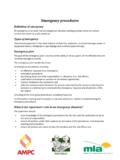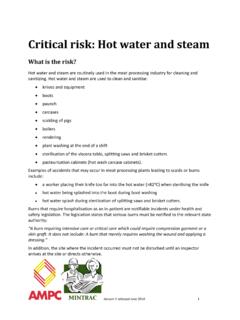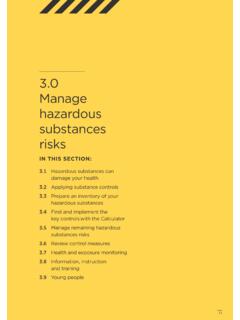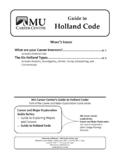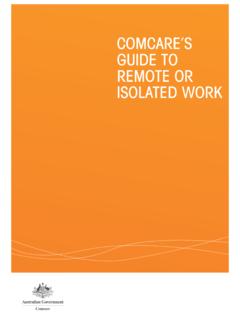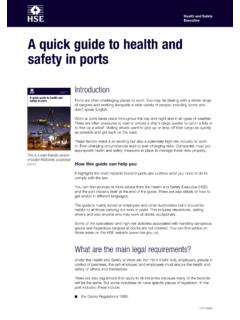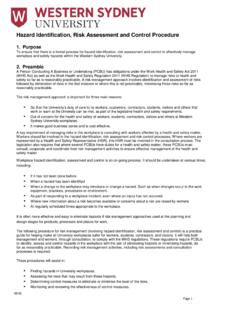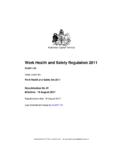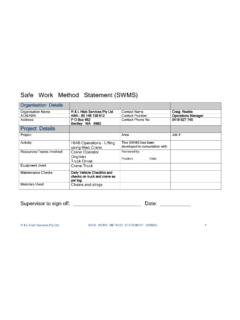Transcription of Critical risk: Housekeeping - Workplace Health and …
1 Version 1 released June 2014 1 Critical risk: Housekeeping What is the risk? Housekeeping practices are part of the Workplace quality program as well as the safety program. Poor Housekeeping practices such as inadequate cleaning of work areas and equipment may lead to a build-up of bacteria that could contaminate meat product. Good Housekeeping is also fundamental to maintaining a clean, tidy and safe working environment. This factsheet focuses on the safety aspects of Housekeeping . In addition, good Housekeeping practices generally reflect good management practices and pride in the Workplace , signalling that the company cares about safety. This is important in an industry that needs to win and maintain the trust of the general public that the company can consistently produce quality product to customer specifications.
2 Worksites that have poor Housekeeping practices with rubbish, waste and broken items around the grounds and a general appearance of poor maintenance do not instil confidence in consumers about the products produced on site. Poor Housekeeping practices may cause accidents in the Workplace and/or provide fuel for fires. Poor Housekeeping practices may lead to slips, trips and falls. These accidents may be the result of: poor maintenance practices inadequate cleaning practices cracked and uneven floors work areas and walkways blocked by waste, equipment, unused items, broken items etc spills hoses and equipment lying around product overflow waste that hasn t been disposed of items that haven t been put away inadequate storage facilities rubbish that hasn t been disposed of Version 1 released June 2014 2 broken items such as broken pallets stacked up against walls According to workers compensation data for 2008/09, slips, trips and falls accounted for 25% of work related injuries (WorkCover Authority of NSW, 2010).
3 How can the risks of poor Housekeeping be reduced to the lowest possible levels? Good Housekeeping practices and supervision are crucial to basic Workplace safety. Work Health and safety laws mandate that senior management must take a risk management approach to minimise the risks to Health and safety in the Workplace . This involves taking a systematic approach to identifying all the risks associated with poor Housekeeping and implementing control measures to eliminate the risks or, if that is not possible, to reduce the risks to the lowest possible level. This includes: identifying cleaning and maintenance requirements in all areas of the Workplace assessing the risks associated with each situation identifying and implementing control measures that reduce the risks to the lowest possible levels reviewing the effectiveness of these control measures and making adjustments as needed conducting regular Workplace inspections that include checking Housekeeping and taking corrective actions as appropriate reporting, investigating and implementing control measures in regard to any incidents to ensure they don t happen again documenting this process so that there is evidence of everything that has been done in the Workplace to reduce the risks to the lowest possible levels conducting training for all staff in the importance of good Housekeeping practices.
4 Their role and the need for them to report hazards to their supervisor. It is important that in identifying control measures the primary focus is on identifying and implementing the most effective control measures. The most effective control measures include elimination, substitution and engineering controls. Every effort should be made to implement these types of control measures. Examples of control measures follow. Version 1 released June 2014 3 Hierarchy of control measures Effectiveness Types of control Examples Most effective Elimination Substitution Resurface floors with hygienic non-slip flooring Isolation Engineering controls Install additional powerpoints Suspend cabling from the ceiling Use stands to store cabling and hoses Regular maintenance program Administrative controls Replace damaged and worn equipment Provide appropriate training, instruction or information in good Housekeeping procedures Least effective Personal Protective Equipment Non slip footwear Pouch belt with safety rings for storing knives and steels Some examples of good Housekeeping practices include.
5 Conducting regular Workplace inspections that include Housekeeping regular cleaning program both during and before and after shifts Workplace procedures for cleaning up spills and other emergency regular, scheduled maintenance program for plant and equipment keeping work areas well maintained, clean, well lit, uncluttered and free of waste cleaning up spills on floors immediately and locating and fixing the cause of spills or leaks keeping walkways clear of obstructions storing materials and equipment neatly and out of the way of production regularly removing waste repairing damaged plant and equipment quickly installing suitable containers for waste products that are conveniently located and regularly emptied to ensure that there is not a buildup of meat products on the floor Version 1 released June 2014 4 having a broom boy during production to keep the production area as clean and tidy as possible.
6 What are my responsibilities as a supervisor? As a supervisor your responsibilities are at two levels. You have responsibilities as a manager and you also have responsibilities as an employee. At the supervisor level of management you are responsible for your area. You implement the systems, policies and procedures in your area and with the team that you manage. As an employee you are responsible to set an example for your own team. Good Housekeeping is the responsibility of everyone in the Workplace . It is important that you set an example for your workers always demonstrating good Housekeeping practices and encouraging your workers to do the same. As a supervisor your role in reducing the risks of poor Housekeeping include: ensuring the work area you are responsible for is maintained in a tidy condition ensuring Workplace policies and procedures for Housekeeping practices are in place and being followed ensuring all your workers are appropriately trained and follow good Housekeeping policy and procedures ensuring any incidents relating to poor Housekeeping are reported, you investigate the incident quickly and take any actions to prevent the incident happening again conducting regular inspections of your work area including cleanliness of floors, correct storage of equipment, hoses, waste bins are routinely emptied to prevent buildup etc.
7 You have legal responsibilities to ensure the safety of your area. If you do not meet your legal responsibilities you may be faced with serious consequences including fines. If you do your job you will be ensuring your work area is as safe as it can be. How do I find further information? For further information you should refer to the relevant legislation in the area. To do this you should go to the work Health and safety authority in your state and search their website for relevant material: WorkCover NSW - Workplace Health and safety Queensland - Version 1 released June 2014 5 Worksafe Vic - SafeWork SA - WorkCover WA - WorkCover Tas - You may also go to the national work Health and safety authority responsible for reforming WHS legislation. This is Safe Work Australia ( ). Relevant publications include: Other publications include: SafeWork Australia, 2013 Model Code of Practice - Managing the Work Environment and Facilities WorkSafe Victoria, Housekeeping WorkSafe Victoria, 2009 Back to basics Site Housekeeping This checklist outlines some simple ways to keep your construction site tidy and your workers safe.
8 WorkCover NSW, 2007 Preventing slips, trips and falls Workplace Health and safety for meat industry supervisors website Critical risk factsheets Slips, trips and falls


